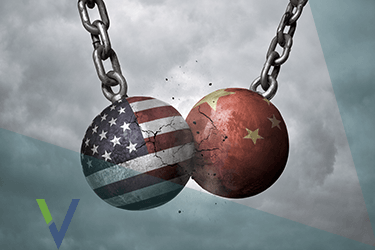Recent Blogs
- Market Outlook Fed Watch Part 2
- Market Outlook Fed Watch
- The Bipartisan Infrastructure Plan and Construction Costs
- Steel Industry Volatility, Risks & Risk Mitigation
- Total Benefit - HVAC
- The Ins and Outs of Insulated Concrete Forms
- Mini Construction Market Update
- Where Did All the Wood Go
- How Do You Price an Elephant
- What if This is the Recession?
- The Pitfalls of Dollar per Square Foot Estimating
Designed to boost domestic production and as part of an economic strategy of “putting America first” President Trump announced on March 1, 2018, his intention to impose a 25% tariff on steel and a 10% tariff on aluminum imports.
At the time NAFTA partners Canada and Mexico were temporarily exempt from the order. However, on May 31, 2018, the same tariffs were applied to Mexico, Canada, and the European Union. The tariffs were enacted via Executive Order which allows the President to impose tariffs at his discretion if the importation of articles identified by the Secretary of Commerce poses a threat to national security. The steel tariff was met favourably by the American Iron and Steel Institute who claim that domestic steel mills could increase production to meet any shortfall in supply caused by the tariffs, although a significant amount of investment would likely be required to re-open mills that have been shut down; ten furnaces producing molten steel have closed since 2002. The Aluminum Association, a Washington advocacy on behalf of the aluminum industry, concedes that some aluminum would need to be imported as they would not be able to satisfy domestic demand. Furthermore, the Aluminum Association has advocated for tariffs targeted at China specifically but not Canada and the European Union.
Potential Effects on North American
The construction industry accounted for 43% of all steel shipments in 2017, according to the American Iron and Steel Institute. With respect to overall building costs, raw steel represents less than 1% of project costs therefore in the short term cost increases should be negligible. While it is early days there does not appear to have been any significant reported spikes in steel pricing. Assuming the steel tariff remains in place for the long term there is speculation as to the true effect of what is, in essence, a paradigm shift. Contractors and sub-contractors will need to evaluate the tariff’s impact from a risk point of view. Domestic mills will fire up to meet demand but that will not be an instantaneous process. Some of the largest mills in the US are 80 years old and are incapable of making the steel needed for high technology and aerospace products. Lead times for large steel orders could lengthen which could have a cascading effect on construction schedules, timing etc. The longer the tariffs existing the higher the potential risk.
Aluminum and steel manufactured products may be more at risk as U.S. trading partners enact retaliatory measures. Lessons learned from President Bush’s 2002 steel tariff appear applicable and it is not disingenuous to assume that the effect of the current tariff may mirror those of President Bush’s steel tariff, which was also based on similar protectionist ideologies.
17 million Americans work in industries that are directly affected by domestic steel, split roughly 60/40 between manufacturing and construction. Ironically, a policy which was designed as a protectionist measure had the opposite effect on sectors that manufacture finished products using steel. The Bush-era tariffs were lifted after 18 months when the World Trade Organization found them illegal. According to a study entitled “The Unintended Consequences of US Steel Import Tariffs: A Quantification of the Impact During 2002”, 200,000 workers lost their jobs during that 18 month period, equating to $4 Billion in lost wages. “Steel tariffs caused shortages of imported product and put U.S. manufacturers of steel-containing products at a disadvantage relative to their foreign competitors.” Realized in 2002, that risk seems just as valid now. Customers of steel containing products will look elsewhere to source product as domestic producers become more expensive. Manufacturers may be put in a position of having to absorb higher steel costs rather than risk losing market share by passing increases to their customers.
Dated February 1, 2018, a letter to President Trump from a consortium of beverage companies that rely on aluminum asserted that, “a tariff of 10% on this aluminum would cost beer and beverage producers $256.3 million… tariffs or import restrictions will have the unintended consequence of harming many healthy downstream U.S. manufacturing industries…tariffs will hurt the U.S. economy more than they will help U.S. smelters”.
While the effect of the tariffs may ultimately benefit domestic US steel and aluminum manufacturers there are broader implications to consider. The Trade Partnership has released a report that suggests that tariffs would increase US iron and steel employment by 33,464 jobs but cost 179,334 jobs throughout the rest of the economy. Job losses should be expected primarily in manufacturing sectors including the fabricated metals and transportation sectors. As can be reasonably expected, retaliatory measures by the US’s major trading partners have commenced.
President Trump’s administration has indicated that the tariffs are aimed at China however it will be Canada that will be most adversely affected by the tariffs. Based on a report published by the Peterson Institute for International Economics, Canada stands to lose $3.2 billion (annually) as compared to a projected loss for China of $689 million (annually). The US government has already established anti-dumping and countervailing duties that limit US steel and aluminum imports from China.
Canada exported $24.1 billion worth of steel and aluminum to the US in 2017. Proportionately speaking Canada exports 45% of its steel to the US. The largest tertiary use of steel is in the automotive sector (26%) and the construction industry (22%). Ontario and Quebec, in particular, stand the lose the most. For example, Hamilton, Ontario has 10,000 people working in the steel industry, conservatively there are in the neighborhood of 30,000 other jobs that rely on the steel industry in Hamilton all of which have been put at risk as a result of the tariffs.
Manufactured steel goods imported from the US will increase in price. This will affect products ranging from automobiles to aluminum cans. Consumers on both sides of the border will be adversely affected.
Conclusions
The US Chamber of Commerce issued a public release which in part states that “The U.S. Chamber is very concerned about the increasing prospects of a trade war, which would put at risk the economic momentum achieved through the administration’s tax and regulatory reforms”. Whether by design or unintentional the current administration’s provocative stance will “provoke widespread retaliation from our trading partners and leave virtually untouched the true problem of Chinese steel and aluminum overcapacity.” As of July 1, Canada has imposed countermeasures on $16.6 billion of imported American goods ranging from steel and aluminum to maple syrup and orange juice. This is the value of Canadian steel and aluminum affected by the Trump Tariffs. There have been similar moves by the European Union and Mexico.
Despite the President’s assertion that “trade wars are good and easy to win”, Reuters recently reported that 80% of 60 economists polled agreed that the President’s import tariffs “will do more harm than good to the US economy… not one respondent said it would benefit the world’s largest economy”.
Rivlyn Manning
Principal
Rivlyn has been in the industry for over 3 decades. Drawing upon his
history background, he enjoys working on cultural and socially significant
projects.












